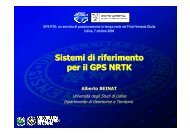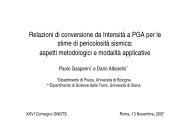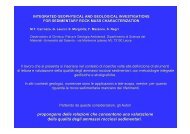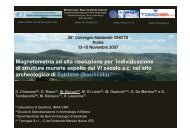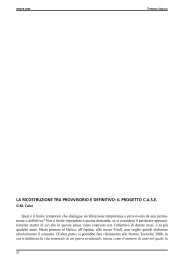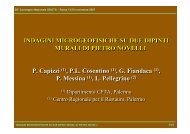You also want an ePaper? Increase the reach of your titles
YUMPU automatically turns print PDFs into web optimized ePapers that Google loves.
GNGTS 2009 SESSIONE <strong>2.3</strong><br />
SEISMIC SITE EFFECTS FOR A PRELIMINARY EVALUATION<br />
OF SEISMIC RISK OF SCHOOL BUILDINGS: A FIRST APPLICATION<br />
ON GEMONA DEL FRIULI AND TARCENTO CASE STUDIES<br />
P. Malisan, S. Grimaz, F. Barazza<br />
Dipartimento Georisorse e Territorio, Università degli Studi di Udine<br />
In Friuli Venezia Giulia (North-Eastern Italy) the ASSESS project (financed by the Regional<br />
Civil Protection and developed by the Istituto Nazionale di Oceanografia e Geofisica Sperimentale,<br />
the University of Trieste and the University of Udine) studies the seismic scenarios of strategically<br />
school buildings. Due to the large amount of buildings that should be investigated (1022) the work<br />
develops in several steps with different widening.<br />
The purpose of the first step is to set a ranking among all the buildings (prioritization), in order<br />
to define the subsequent ranking analyses. The ranking is based on values of risk evaluated simply<br />
by computing the potential damage of a building, and sorting the results first in descending order of<br />
potential damage, and secondly by considering the number of students presents in each building.<br />
The data used are obtained from the “Anagrafe degli edifici scolastici” database (from now on,<br />
called “Anagrafe” database, i.e. a register of school buildings), available for almost all the school<br />
buildings of the Region. In this paper the authors present the results on potential damage obtained<br />
using the macroseismic method proposed by Lagomarsino and Giovinazzi (2006). This method has<br />
been adapted to the available data (i.e. the ones of the “Anagrafe” database). Shortly, the Lagormarsino<br />
and Giovinazzi method consists in assigning to each building a vulnerability base score<br />
depending from its typology; afterwards some modifiers are computed by looking at all the features<br />
(available into the database) able to affect the seismic behavior. The method and the ranges derive<br />
from the EMS-98 macroseismic scale (Grünthal, 1998), and are defined starting from statistical<br />
considerations. For further information on the application and the results of the method, see Malisan<br />
et al. (2009).<br />
In this work the authors will highlight the importance of the evaluation of the action (seismic<br />
input) in the final definition of the potential damage. The function that defines the potential damage<br />
is defined in Lagomarsino and Giovinazzi (2006) article, and characterizes the potential<br />
(expected) damage through the EMS-98 damage grades.<br />
First of all, the vulnerability index for each school building has been computed, as described<br />
above. The evaluation of the potential damage has been done by using the values of peak ground<br />
acceleration both starting from the values of the seismic zones both from the “punctual” values of<br />
PGA defined by Gruppo di Lavoro (2004) for the<br />
whole Nation.<br />
In the Friuli Venezia Giulia Region exists also a<br />
map of the NEHRP zones (ASSESS, 2009). The data<br />
of this map have been used to improve the evaluation<br />
of the potential damage in the first level of the project.<br />
The results are plot in Fig. 1, where in most of the<br />
cases the value of potential damage calculated from the<br />
value of PGA of the zone is higher than the one calculated<br />
with the punctual PGA, but there are some cases<br />
particularly significant in which the value of a g punctual<br />
is higher than the other (i.e. the ones in zone 4 and<br />
some buildings in the 3 rd zone). In the figure, the dots<br />
Fig. 1 – Comparison among potential damage calculated from<br />
the value of PGA of the zone and the one calculated with the<br />
punctual PGA.<br />
460




